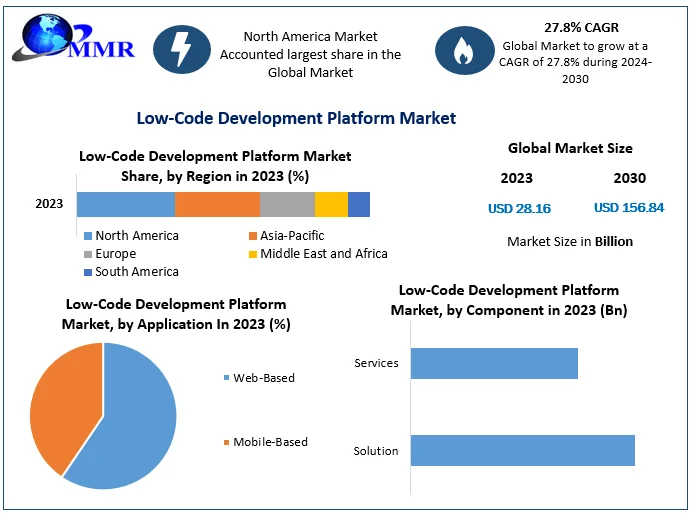Free Suggestions For Choosing Low-Code Platform Recommendations
Wiki Article
Benefits Of Low-Code Application Development For Non-Developers
Because of a variety of reasons the development of low-code applications is more accessible for non-developers. These are often called "citizens developers."
Drag-and-Drop Builders. Low-code platforms include drag-and-drop interfaces. This allows non-developers the ability to build applications in a visual manner, without writing code. Development is now easier for people with no technical background.
WYSIWYG editors The WYSIWYG editors "What You See is What You get" editors allow users to build interfaces and workflows that look like the final version. This makes it simpler to learn and use.
Simplified Workflow and Logic Design:
Visual Workflow Modeling: Users may develop business processes and apply logic through visual flowcharts and models that are more intuitive than traditional coding methods.
Pre-built Logic components Low-code platforms have logic components already built (e.g. conditional statements and loops), which can be easily configured which eliminates the need for complicated coding.
Reusable Components and Templates
Libraries of Templates that are pre-built A lot of platforms that allow low-code also have templates available for the most common applications. This allows developers to start quickly and efficiently while non-developers are able to customize the templates however they see appropriate.
Reusable Widgets and Modules: With the help of the reuse of modules and widgets users can simplify the design process, while also reducing the requirements for technical expertise.
Guided development and tutorials:
Step-byStep Guides: Platforms will often offer guided development paths, online tutorials, or on-screen directions to help users who aren't developers to create applications.
Interactive Tutorials. Interactive, hands-on tutorials allow users to gain knowledge by doing.
Integration with Existing Tools:
Easy Integration - Low-code platforms are easily integrated into existing systems and tools for business (e.g. ERP, CRM) that give even non-developers to create apps that fit within their workflows.
APIs connectors and APIs: These devices make integration easier by allowing non-developers (or even end users) to connect their apps to external services.
Collaboration Features:
Team Collaboration Features, like real-time collaboration and shared workspaces, help non-developers and professionals to collaborate efficiently.
Access Control Based On Roles: Non-developers are able to be assigned roles and access levels that permit their participation without compromising functionality or security.
Automated Testing and Debugging:
Low-code platforms include tools to test and debug that are built in. They automate this process, making it easier for nondevelopers to ensure their apps function.
Error Highlighting: Whenever problems arise the platform flags mistakes and suggests solutions by guiding non-developers through troubleshooting techniques.
The primary benefit of developing low-code applications for accessibility to non-developers comes due to its ability to decentralize the development process. By offering intuitive, visually-guided tools and experiences, low code platforms let business owners actively participate and maintain applications. View the best wavemaker.com coding for website advice including cross platform mobile dev, application development platforms, develop mobile application, push notifications, app platforms, cross platform mobile dev, no code platforms, build a docker container, microsoft azure sql, low code platforms and more.

Cost-Effectiveness Is Among The Many Advantages Of Developing Apps That Use Low-Code.
The low-code approach to application development is a cost-effective solution with many benefits. It's a great option for companies who want to make the most of their budgets and deliver quality apps. These are the major benefits reduction in development costs:
Fewer Coding Requirements: Low codes platforms remove the need for lengthy hand-coded apps. Developers are able to spend less time and effort developing applications. This results in lower costs for labor.
Reduced Developer Resources: Since low-code is faster and simpler to create, less skilled developers will be required. This can drastically reduce the cost of hiring and staffing.
More Time to Market
Accelerated Cycle of Development Visual tools that are low-code and components allow for rapid application creation, which allows businesses to launch new products quicker. This can lead faster revenue growth and improve your position in the marketplace.
Rapid prototyping: By developing and testing prototypes in a short time companies can cut down on the time they spend in the development phase and allow for quicker iterations based on user feedback.
Lower Maintenance Costs
Simple Maintenance: Applications developed on low-code platforms tend to be more simple to maintain due to their modular components and standard architecture. This lowers the costs of ongoing maintenance.
Automated Updates: A lot of low-code software platforms manage patches and updates in a way that is automatic making sure that applications remain safe and up-to date without needing lengthy manual intervention.
Efficient Resource Utilization:
Low-code platform contributions let both business users and other non-developers participate in the process of creating. This democratization allows businesses to make use of the expertise of many employees, and lessen their dependence on highly paid programmers.
Improved utilization of IT resources: IT departments will be able focus on strategic projects, instead of being bogged down in routine development tasks. This will increase overall productivity and efficiency.
Scalable Pricing Models
Subscription pricing: A lot of low-code platform offer flexible pricing plans for subscriptions that scale with usage. This gives businesses the capability to match their spending to the growth of their business and its needs without incurring large upfront costs.
Pay-Assosiated Option: A few platforms offer pay-assosiated alternatives. These options ensure that companies are only liable for the services used which is advantageous to startups and small business with limited funds.
Reduce the cost of third-party software:
Low-code platforms are built-in with functionality and integrations that can lower the cost of software subscriptions and licensing.
Pre-Built Integrations: The availability of pre-built integrations for popular platforms and services eliminates the requirement for custom development, saving both time and money.
Increased ROI
A faster return on investment Rapid development: By combining less expense and a shorter time to market, companies can achieve an increased return on their investments (ROI).
Increased Ability. Businesses will be able to adapt quickly to ever-changing market conditions and customer requirements. This will help them remain relevant, and they will be able to profit from any new opportunities.
Lower Training Costs
User-Friendly Interfaces: The intuitive interfaces and user-friendly functions of low-code platforms help to reduce the learning curve, eliminating the need for intensive training.
Accessible Resources: Many platforms using low-code provide extensive training materials, tutorials and community support. This means that there is less need for formal education and costs associated with it.
Collaboration Streamlined:
Collaboration Tools: Collaboration tools integrated enhance communication and coordination between teams, which results in better processes for development, and less overhead.
Unified Development Environment: A single, unified development environment helps simplify workflows and decreases the difficulties and expenses associated with managing multiple platforms and tools.
Overall, the efficiency of software development using low-code is due to its capability to cut down on maintenance and development costs and increase time to market and optimize the use of resources and offer flexible pricing models. These aspects provide significant economic rewards for businesses. Low-code is a fantastic option for businesses that want to increase budgets while still being able to create robust, scalable and top-quality software. View the top rated description for Enterprise application development with Low-code Platform for website info including application modernisation, cross platform mobile app development, mobile development platforms, microsoft azure sql, cross platform mobile development, app platforms, develop mobile application, software for app development, jdbc server, app modernization and more.

Benefits Low-Code App Development In Terms Limitations And Customization
Low-code design for applications is an equilibrative, flexible method that takes into account the limitations of the system and allows for modification. Here are a few key advantages.
The Challenge of Overcoming Complexity Barriers
Simplified Development : Low-code platform simplifies development by supplying templates and components that are pre-built. This allows rapid creation and deployment.
Guided Workflows: Many platforms offer guided workflows and wizards to help developers navigate through the maze of processes, decreasing the risk of mistakes and ensuring consistency.
Scalability Solutions
Scalability is a part of the Low-code platforms typically include features that enable an architecture that is scalable. Applications can handle increasing loads with minimal changes.
Performance Monitoring Performance Monitoring Tools: Integrated performance monitoring tools and optimization tools ensure that the applications run as efficiently as they can be, regardless of the size of their application.
Security and compliance:
Integrated Security Features: Low-code systems come with built-in security measures including encryption, role-based access control, and automated compliance checks, addressing common security concerns.
Platforms update frequently their security protocols to make sure that they comply with regulations. This helps to keep platforms safe from new threats.
Customization:
Extensibility:
Low-code Platforms Support Custom Code They allow the integration and usage of custom code.
Moduls and custom plugins Developers can create custom plug-ins or modules that provide specific functionality specifically tailored to the needs of a company.
APIs and integration:
API Support: Comprehensive APIs support is provided to allow seamless integration and communication with external systems.
Third-Party Services: Low-code platform often provides pre-built connections for popular services provided by third-party providers which makes integration and customization easier.
Flexible design of UI/UX:
Customizable user interfaces: Developers are able to modify and design the user interfaces so that they fulfill specific branding requirements as well as usability needs, providing an experience that is customized for users.
Responsive Designs: The software can be tailored to fit different sizes of screens and devices.
Custom Business Logic for Businesses:
Visual Workflow Builds: Visual tools that allow for the customization of business workflows and rules, and also to create complex, tailored processes.
Platforms include conditional Logic, which allows for the creation of custom scripts to address specific scenarios and business rules.
Data Management:
Custom Data models: Developers are able to design a custom data model to satisfy specific requirements of an application, and ensure that data handling meets the requirements of business.
Advanced Data Processing Integration and advanced data handling tools allow for the customisation of the data analysis process and use in the program.
Balance Customization and Limitations:
Frameworks and Standards
Low-code platforms comply with industry standards and best practices. This ensures secure and high-quality applications.
Governance Frameworks built-in governance frameworks guarantee that the customizations don't interfere with the integrity, security or security of the application.
Iterative design and feedback:
Rapid prototyping. Developers can iterate and improve applications based on user feedback.
Continuous Improvement: Low-code systems support continuous improvement, which allows for continuous customization and improvement as the business needs change.
User Empowerment
Low-code platforms allow citizen developers to develop: By allowing non-developers, with intuitive interfaces, to personalize applications, they broaden the pool contributors that can improve and customize apps.
Support and Training Tools: A lot of platforms offer extensive training and support materials to allow users to customize their applications without compromising stability or performance.
In general, low-code application development offers a solid system to overcome weaknesses and provides a wide range of customization opportunities. This balance ensures businesses can develop and maintain applications that are customized and efficient to meet their individual needs, while ensuring the highest standards of security, quality, and scalability.
